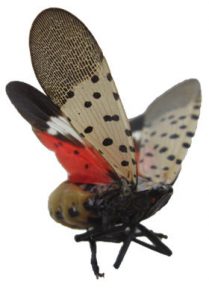
By Chad I. Schwartz
When you hear the word “quarantine,” what images come to mind? Perhaps you envision an infected person isolated amid an epidemic, or even recall the aid workers who were confined following their return to the U.S. from Ebola-stricken West Africa. While you may imagine strings of black and yellow “caution” tape cordoning off a contaminated area, you probably don’t picture a vibrantly spotted red and gray insect with an appetite for fruit trees and grapevines. But for residents of several townships in nearby Berks, Montgomery, Bucks, and Chester counties, the word “quarantine” is now associated with just that – a colorful but potentially destructive insect called the spotted lanternfly (Lycorma delicatula).
Making its unwelcomed North American debut in Pike Township, Berks County less than two years ago, the spotted lanternfly has since colonized adjacent townships and counties, prompting the Pennsylvania Department of Agriculture (PDA) to enact a general quarantine in an effort to contain the insect. Much as a conventional quarantine is authorized to restrict the dispersion of a pathogen, PDA’s quarantine is intended to limit the spotted lanternfly’s distribution to localized pockets by prohibiting the transport of objects that may carry the insects and their eggs. Therefore, as per PDA order, the following objects are not permitted to be moved beyond the quarantine zone: plant materials (including firewood and yard waste), construction materials, grills, lawn furniture, vehicles stored outdoors, and any other surfaces that may carry any stage of the insect’s life cycle. Individuals who fail to obey the requirements of the quarantine could be criminally prosecuted (with penalties of up to 90 days imprisonment and a fine of up to $300 per violation), and face civil penalties of up to $20,000 per violation. But why make such a big fuss over an insect barely larger than a quarter?
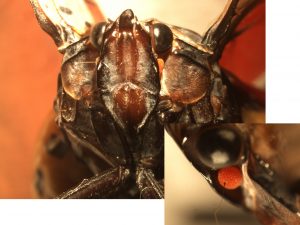
Native to northern China, the spotted lanternfly is a ‘vegetarian’ that has a fondness for many plants of local, regional, and global economic importance. As members of the insect Order Hemiptera, lanternflies have sucking mouthparts, and therefore cannot chew plants as, for example, a caterpillar generally would. Instead, adults and nymphs suck phloem – plant tissues that carry sugars – from leaves and stems. But what goes in must come out! In fact, while feeding damage alone may weaken host plants, it is the lanternfly’s habit of peeing sugary liquids onto the plants it eats that makes it a particularly harmful pest! As sugary excrement collects on plant surfaces, resulting mold growth can ultimately slow or stop plant growth, and attract other insects that may further damage the plant (Dara 2014). Far from a picky eater, the spotted lanternfly is known to consume in excess of 70 plant species, 25 of which currently grow in Pennsylvania, according to PDA. Such host plants as apples, birches, cherries, grapes, maples, and stone fruits might be at risk of damage if the lanternfly spreads in North America (Dara 2014). Research suggests that the lanternflies may locate preferred host plants by ‘smelling’ attractive plant compounds through their antennae (Moon et al. 2011; Yoon et al. 2011).
While considered a pest in its native China, the species gained a more notorious reputation as an invasive species in South Korea and Japan, where, since its introduction and rapid spread in 2006, it has targeted grapes, fruit trees, and ornamental plants (Barringer et al. 2015). To be characterized as “invasive,” a species must be nonnative, and exhibit the potential to harm the environment, economy, and/or human health. If the lanternfly’s impact on Korea and Japan serves as any indication of the insect’s invasive potential, it is clear why a quarantine is so important: PDA fears that Pennsylvania’s multimillion-dollar agriculture, wine-making, nursery, and timber industries provide prime fodder for a growing population of hungry lanternflies. Athough it is unclear how the insect was introduced to Berks County, its containment and eradication within the quarantine zone is essential to averting a statewide, and possibly a continent-wide, invasion.
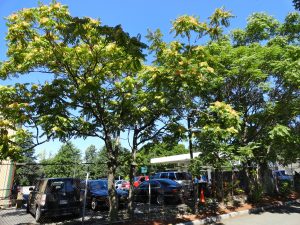
Thousands of miles from its native range, the lanternfly is thriving in the absence of natural predators, and its population is expanding as it exploits Pennsylvania’s vegetation. Yet, much of what makes the lanternfly such a successful invader actually has to do with another nonnative species, the tree of heaven (Ailanthus altissima). An abundant invasive species in Pennsylvania, but originating in the lanternfly’s native range, tree of heaven is a woody plant that outcompetes other plants by releasing toxins into the soil. Rather than avoiding the toxins, lanternflies actually eat them, making the tree of heaven a preferred host species for the insect (Dara et al. 2015).
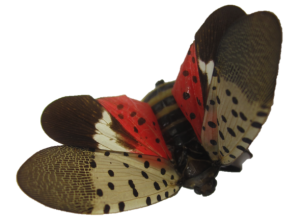
The spotted lanternfly is a strikingly colored insect whose appearance varies from a white-spotted, black or red nymph to a black-spotted, gray and red adult over the course of its life cycle. But don’t let its handsome appearance fool you! In nature, flashy colors often serve to communicate one important fact to potential predators: “I am poisonous, so you better not eat me!” As the lanternfly consumes tree of heaven, the plant’s toxic compounds are concentrated in the lanternfly’s tissues. Thus, while the lanternfly has no natural predators in North America, even native predatory animals such as birds may be deterred by the insect’s toxicity (Dara et al. 2015). Amazingly, the toxic properties of lanternflies have long been valued in Chinese medicine, having been used to treat swelling as early as the 12th century.

Come fall, adult lanternflies prefer to eat, mate, and deposit egg masses exclusively on tree of heaven, likely because the tree’s toxic compounds discourage egg predation (Dara et al. 2015). In fact, it was on a tree of heaven that the first North American lanternflies were identified by PDA and the PA Game Commission in the fall of 2014 (Barringer et al. 2015). Due to its abundance in Pennsylvania, and its importance to the lanternfly life cycle, tree of heaven has received a lot of attention in eradication efforts.
Toxicity isn’t the lanterfly’s only ‘super power.’ Frantsevich et al. (2008) determined that specialized foot structures allow spotted lanternflies to adhere to smooth, vertical and horizontal surfaces. Much like Spiderman, the insects can even walk upside down on glass and plastic! While this ability helps the lanternfly to traverse surfaces where it may feed and/or lay its eggs, its well-designed foot structures have actually inspired scientists to engineer shoe soles for climbing robots (Voigt et al. 2012).
PDA estimates that the scraping of lanternfly egg masses from various surfaces had eradicated over 600,000 individual insects in Pennsylvania by December 2015. This number not only attests to the success of eradication efforts, it also reveals the true scale of the insect’s proliferation in Pennsylvania. Aside from egg mass scraping, the PDA has also applied sticky tree bands to host trees as a means of catching lanternfly nymphs. Other proposed lanternfly population management methods include pesticide application, as well as biological control using a parasitoid wasp (native to Asia) that targets lanternfly eggs (Kim et al. 2011). Lab and field research also suggests that lavender oil effectively repels lanternflies, and could be applied to crops to discourage the insects from feeding (Yoon et al. 2011). Similar research suggests that spearmint oil actually attracts lanternflies, and could be incorporated into traps (Moon et al. 2011). Research and evaluation, supported by USDA funding and volunteer efforts, are ongoing, and are directed toward the ultimate goal of eliminating the lanternfly before it becomes a pervasive pest.
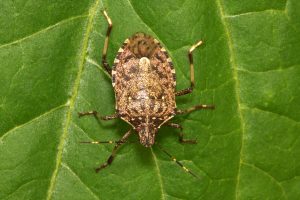
Interestingly, the spotted lanternfly is not the first insect to put our region on the map. Are you familiar with those pesky brown bugs that fly clumsily around your house and smell when you squash them? Known as brown marmorated stink bugs, these cousins of the spotted lanternfly have gained notoriety across much of the U.S. since they were introduced to Allentown in 1998. Fears of a similar invasion are a driving force behind current lanternfly eradication efforts.
So, what can you do to prevent a spotted lanternfly invasion? Through a carefully coordinated effort involving experts and volunteers, it may be possible to prevent repeats of the American stink bug and Korean/Japanese lanternfly invasions. First, you need to know what to look for. Though generally deposited on tree trunks, brown, waxy egg masses can be found on any flat surface, including outdoor furniture, walls, and vehicles (PDA 2016). Also watch out for wingless nymphs, which range in size from about one-fifth to three-quarters the diameter of a penny, and can be found feeding on small plants, vines, and tree of heaven (Dara et al. 2015; PDA 2016). Winged adults may feed on a variety of host plants. Also, don’t overlook signs that lanternflies have been feeding on your trees (especially tree of heaven). Tree wounds and fungal growth may very well be (but are not necessarily) an indicator that lanternflies have been feeding. If you do find lanternflies or eggs within or beyond the quarantine zone, do not hesitate to contact PDA (badbug@pa.gov) or your local Penn State Extension Office!
While shooing European Starlings or pulling Japanese stiltgrass from your backyard, don’t forget about our area’s newest nonnative species, the spotted lanternfly. Though it is tiny, it could pack a big punch on plant based industries in Pennsylvania and beyond. Unfortunately, we live in an age in which the introduction of invasive species is inevitable. But, as with a contagion, vigilance and quick action can stop a localized case from going epidemic. So if you enjoy fruit, wine, hardwood floors, or a nicely landscaped yard, be grateful for Pennsylvania’s lanternfly quarantine!
Visit the PDA webpage to view images of the various spotted lanternfly life stages, learn how to assist with eradication efforts, report sightings, or explore this subject in greater depth. The Penn State Extension and USDA websites also include important information regarding the ongoing spotted lanternfly threat.